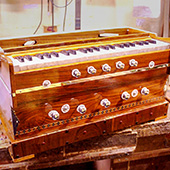Design Resource
Making of Harmonium - Ahmednagar, Maharashtra
Musical Instrument Making
by
Prof. Bibhudutta Baraland Srikanth B.
A harmonium is a musical instrument that produces sound when air is blown through its reeds, creating different pitches to make musical notes. The device is also called a "melodeon", "reed organ" or "pump organ" as it shares similarity with an organ. Though harmonium was first introduced in the west, it now largely inhibits the Asian continent especially India. Its prevalence is so wide that many believe it is an instrument of Indian origin. Harmonium was first invented by Christian Gottlieb Kratzenstein (1723-1795), a professor of physiology from Copenhagen, Denmark. Kratzenstein built a small pneumatic organ fitted with free reeds, a design which bagged an award from the Academy of Science at St Petersburg. Later it was altered by Gabriel Joseph Grenie from France, who called it a drogue express. Grenie’s instrument was then modified by Alexandre Debain, who coined and patented the current name ‘Harmonium’ in 1840. After Europeans immigrated to the United States, this technique of making a portable keyboard instrument was soon adopted by Americans; thus, prominent firms like Mason & Hamlin and the Estey Organ Company stepped into manufacturing the instrument. Its characteristics of comparatively lightweight body and heat resistance made it a user-friendly affair for Britishers. They carried it to their colonies to enrich their religious affairs and social get-togethers. It is believed that the predecessor of the modern version was first developed in the 19th Century by artisans from France, which slowly traveled to India via their British colonizers. By the 1900s, varied styles of harmoniums were already in the market, which ranged from simple to larger kinds with ornate cases, a dozen stops, and even couplers. Some complex forms came with pedal keyboards and electrical pumps that required assistants to run bellows.
In India, Harmonium comes in a small portable box size which is a key tool in teaching students the rudiments of music and songs. The instrument that got introduced to Indian music from Calcutta now enjoys a principal instrument in rural folk songs, semiclassical and classical music, ghazals, kathak, thumri, khayal, qawwali, and other ancient Sufi tradition as well, practiced across the country. Out of the many types available in the market, like Compact Harmonium, Harmonium with Coupler, Scale Changer Harmonium, Samvadini Harmonium, Samvadini Harmonium is the one upgraded from the traditional form and improvised with a ‘swarmandal’ (harp-like box). It renders cut notes and high-speed passages, thus giving a full sound pattern. Om Nada Brahma is a harmonium manufacturing center based in Ahmednagar, where different kinds of harmoniums are produced and traded for many decades. Prashanth Subha Jadhu is the proprietor cum senior artisan at the center who runs the business efficiently.






